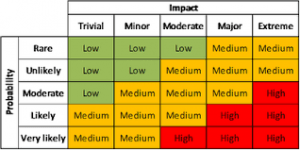Risk Management in Construction Projects
Risk Management in construction projects is carried out to minimize the impact of adverse events and keep the project running smoothly. A risk is an uncertain event that may have a positive or negative effect on the project. The risk management process consists of the following steps:
- Identify Risks
- Analysis of the Risks
- Planning & Controlling Risks
Risk Identification
The first step in the risk management process is to identify the project’s risks. It requires the collective effort of the project team and the stakeholders. The identification of all the risks should be made as soon as possible. In addition to that, regular meetings with the key team members are essential to identify all the risks that may incur during the project’s life cycle.
Risk Analysis
After the identification, the risks are categorized based on the probability of occurrence and their impact on the project. The risks that are of high probability and their impact is very high should be dealt with at the earliest. Consider a construction project which has only one batching plant, and the plant breaks down during the pile concrete pour. Now, if the pour has not been completed, the contractor has to abandon it and cast two additional piles at his own cost. It is the type of high impact high probability risk. A competent Project Manager is one who had already identified this risk and made a contract with a ready-mix concrete supplier to provide emergency concrete. It will save the company from hefty losses. The Risk impact/probability matrix is shown below.

Planning & Controlling Risks
After the risk analysis effort is completed, it is now time to develop a strategy to tackle the risks. There are four strategies to deal with negative risk.
- Avoid
- Transfer
- Mitigate
- Accept
Avoid:
Some risks in construction can be avoided easily. Consider a project where a penalty will be imposed on the contractor if he fails to deliver on time. This type of risk is prevented by making a realistic project schedule or adding additional resources to meet the targets. Similarly, the risk of rework can be avoided if proper internal quality checks are applied to every stage of the project, starting from the layout of the building to the final pour.
Transfer:
This is a strategy to transfer the impact of risk to a third party. Suppose we have included a clause in the contract with the material supplier that he is bound to supply materials at the same cost for a period of one year, and if the fuel prices increase, then the impact will not be transferred to us. Similarly, we may hire specialized sub-contractors for shuttering, or steel fixing, and the risk of cost overrun is assigned to them. In this case, the sub-contractor has to meet the deadline, and if an additional workforce is required, he will manage at the same cost.
Mitigate:
This is the response strategy where the project team will reduce the probability of a risk occurrence. An example of this strategy is to rely on more than one supplier to fulfill the raw material needs for concrete production.
Accept:
The risk acceptance strategy is used when it is impossible to address the specific risk unless it occurs. This type of approach is adopted if there are budget constraints, and no particular action can be taken. If the project is being executed at a location far away from the city and the budget allows only one concrete pump deployment at the site. In case the pump breaks down, the only solution would be to wait for its repair. It is important to mention that only those risks could be accepted, which don’t have high impacts on the project.
Conclusion
Risk management depends on the collective efforts of the project team. It is necessary to keep the team informed about the probable risks and prepare the team to deal with the risks without hampering the project’s pace. The project’s success highly depends on the right risk management strategy adopted to lessen/minimize its impact. Contact Leopard Project Controls to minimize risks in your construction projects.





